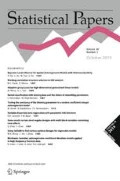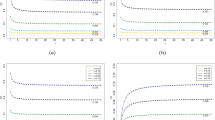Abstract
For a sequence of multi-state trials with l possible outcomes denoted by \( \left\{ 1,2,\ldots ,l\right\} \), let E be the event that at least \(k_{1}\) consecutive 1s followed by at least \(k_{2}\) consecutive 2s,..., followed by at least \(k_{l}\) consecutive ls. Denote by \(T_{r}\) the number of trials for the rth occurrence of the event E in a sequence of multi-state trials. This paper studies the distribution of the waiting time random variable \(T_{r}\) when the sequence consists of independent and identically distributed multi-state trials. In particular, distributional properties of \( T_{r}\) are examined via matrix-geometric distributions.
Similar content being viewed by others
References
Aki S (2019) Waiting time for consecutive repetitions of a pattern and related distributions. Ann Inst Stat Math 71:307–325
Aki S, Kuboki H, Hirano K (1984) On discrete distributions of order \(k\). Ann Inst Stat Math 36:431–440
Antzoulakos DL, Chadjiconstantinidis S (2001) Distributions of numbers of success runs of fixed length in Markov dependent trials. Ann Inst Stat Math 53:599–619
Antzoulakos DL, Bersimis S, Koutras MV (2003) Waiting times associated with the sum of success run lengths. In: Lindqvist B, Doksum K (eds) Mathematical and statistical methods in reliability. World Scientific, Singapore, pp 141–157
Balakrishnan N, Koutras MV (2002) Runs and scans with applications. Wiley, New York
Balakrishnan N, Mohanty SG, Aki S (1997) Start-up demonstration tests under Markov dependence model with corrective actions. Ann Inst Stat Math 49:155–169
Balakrishnan N, Koutras MV, Milienos FS (2014) Start-up demonstration tests: models, methods and applications with some unifications. Appl Stoch Models Bus Ind 30:373–413
Bladt M, Nielsen BF (2017) Matrix-exponential distributions in applied probability. Springer, New York
Dafnis SP, Antzoulakos DL, Philippou AN (2010) Distributions related to \((k_{1}, k_{2})\) events. J Stat Plan Inference 140:1691–1700
Eryilmaz S (2022) Discrete stochastic models and applications for reliability engineering and statistical quality control. CRC Press, Boca Raton
Eryilmaz S, Tank F (2021) Computing minimal signature of coherent systems via matrix-geometric distributions. J Appl Probab 58:621–636
Feller W (1968) An introduction to probability theory and its applications, vol I. Wiley, New York
Fu JC (1986) Reliability of consecutive-\(k\)-out-of-\(n\): F system with \((k-1)\)-step Markov dependence. IEEE Trans Reliab 35:602–606
Fu JC, Hu B (1987) On reliability of a large consecutive-\(k\)-out- of-\(n\): F system with (\(k-1\))-step Markov dependence. IEEE Trans Reliab 36:75–77
Fu JC, Koutras MV (1994) Distribution theory of runs: a Markov chain approach. J Am Stat Assoc 89:1050–1058
Fu JC, Lou WYW (2003) Distribution theory of runs and patterns and its applications: a finite Markov chain imbedding approach. World Scientific, Singapore
Fu JC, Lou WYW, Chen SC (1999) On the probability of pattern matching in nonaligned DNA sequences: a finite Markov chain imbedding approach. In: Claz J, Balakrishnan N (eds) Scan statistics and applications. Birkhauser, Boston, pp 287–302
Glaz J, Koutras MV (2019) Handbook of scan statistics. Springer, New York
Huang W, Tsai C (1991) On modified binomial distribution of order \(k\). Stat Probab Lett 11:125–131
Knuth DE (1997) The art of computer programming: seminumerical algorithms, vol 2, 3rd edn. Addison-Wesley Longman Publishing, Co. Inc., Boston
Kong Y (2022) Multiple consecutive runs of multi-state trials: distributions of \((k_{1},k_{2},\ldots ,k_{l})\) patterns. J Comput Appl Math 403:113846
Koutras MV (1997) Waiting times and numbers of appearances of events in a sequence of discrete random variables. In: Balakrishnan N (ed) Advances in combinatorial methods and applications to probability and statistics. Birkhauser, Boston, pp 363–384
Koutras MV, Alexandrou VA (1995) Runs, scans and urn model distributions: a unified Markov chain approach. Ann Inst Stat Math 47:743–766
Koutras MV, Rakitzis AC (2019) Control charts with random interarrival times between successive samplings. Appl Stoch Models Bus Ind 35:651–670
Kumar AN, Upadhye NS (2019) Generalizations of distributions related to \((k_{1}, k_{2})\)-runs. Metrika 82:249–268
Makri FS (2010) On occurrences of F–S strings in linearly and circularly ordered binary sequences. J Appl Probab 47:157–178
Makri FS, Philippou AN (2005) On binomial and circular binomial distributions of order \(k\) for \(l\)-overlapping success runs of length \(k\). Stat Pap 46:411–432
Makri FS, Psillakis ZM (2013) Exact distributions of constrained \( (k, l)\) strings of failures between subsequent sequences. Stat Pap 54:783–806
Makri FS, Philippou AN, Psillakis ZM (2007) Shortest and longest length of success runs in binary sequences. J Stat Plan Inference 137:2226–2239
Montoro-Cazorla D, Perez-Ocon R (2010) System availability in a shock model under preventive repair and phase-type distributions. Appl Stoch Models Bus Ind 26:689–704
Moore PT (1958) Some properties of runs in quality control procedures. Biometrika 45:89–95
Neuts MF, Meier KS (1981) On the use of phase-type distributions in reliability modeling of systems with two components. OR Spektrum 2:227–234
Philippou AN, Makri A (1986) Success, runs and longest runs. Stat Probab Lett 4:211–215
Philippou AN, Georgiou C, Philippou GN (1983) A generalized distribution and some of its properties. Stat Probab Lett 1:171–175
Sen K, Agarwal M, Bhattacharya S (2006) Polya–Eggenberger F–S models of order \((k_{1}, k_{2})\). Studia Sci Math Hung 43:1–31
Sinha K, Sinha BP, Datta D (2010) CNS: a new energy efficient transmission scheme for wireless sensor networks. Wirel Netw J 16:2087–2104
Upadhye N, Kumar A (2018) Pseudo-binomial approximation to \( (k_{1}, k_{2})\)-runs. Stat Probab Lett 141:19–30
Zhao X, Song Y, Wang X, Lv Z (2022) Distributions of \( (k_{1},k_{2},\ldots ,k_{m})\)-runs with multi-state trials. Methodol Comput Appl Probab. https://doi.org/10.1007/s11009-022-09948-z
Acknowledgements
The authors thank the anonymous referees for their helpful comments and suggestions, which were useful in improving the paper.
Author information
Authors and Affiliations
Corresponding author
Additional information
Publisher's Note
Springer Nature remains neutral with regard to jurisdictional claims in published maps and institutional affiliations.
Rights and permissions
Springer Nature or its licensor holds exclusive rights to this article under a publishing agreement with the author(s) or other rightsholder(s); author self-archiving of the accepted manuscript version of this article is solely governed by the terms of such publishing agreement and applicable law.
Springer Nature or its licensor holds exclusive rights to this article under a publishing agreement with the author(s) or other rightsholder(s); author self-archiving of the accepted manuscript version of this article is solely governed by the terms of such publishing agreement and applicable law.
About this article
Cite this article
Chadjiconstantinidis, S., Eryilmaz, S. Computing waiting time probabilities related to \( (k_{1},k_{2},\ldots ,k_{l})\) pattern. Stat Papers 64, 1373–1390 (2023). https://doi.org/10.1007/s00362-022-01351-7
Received:
Revised:
Accepted:
Published:
Issue Date:
DOI: https://doi.org/10.1007/s00362-022-01351-7



